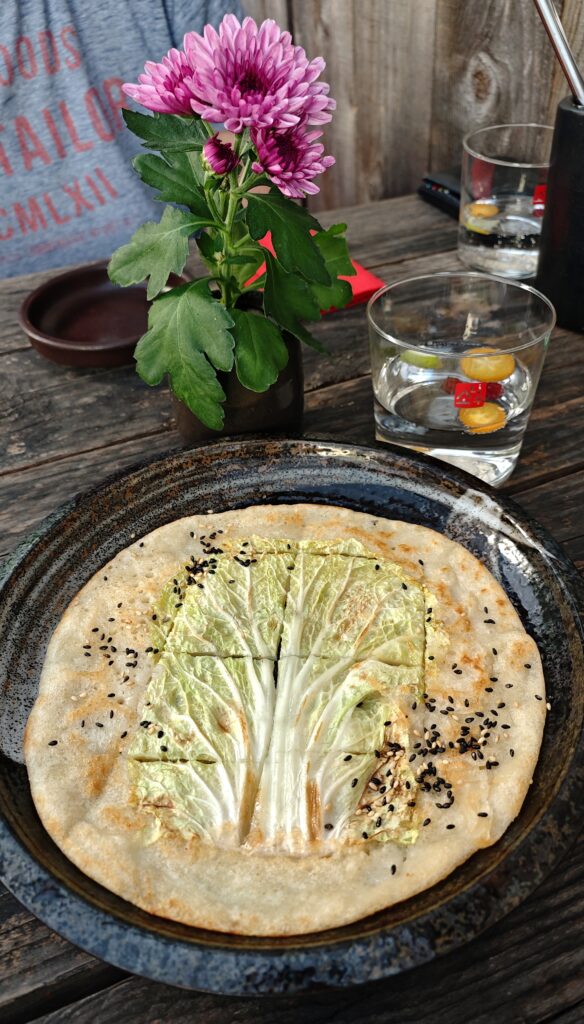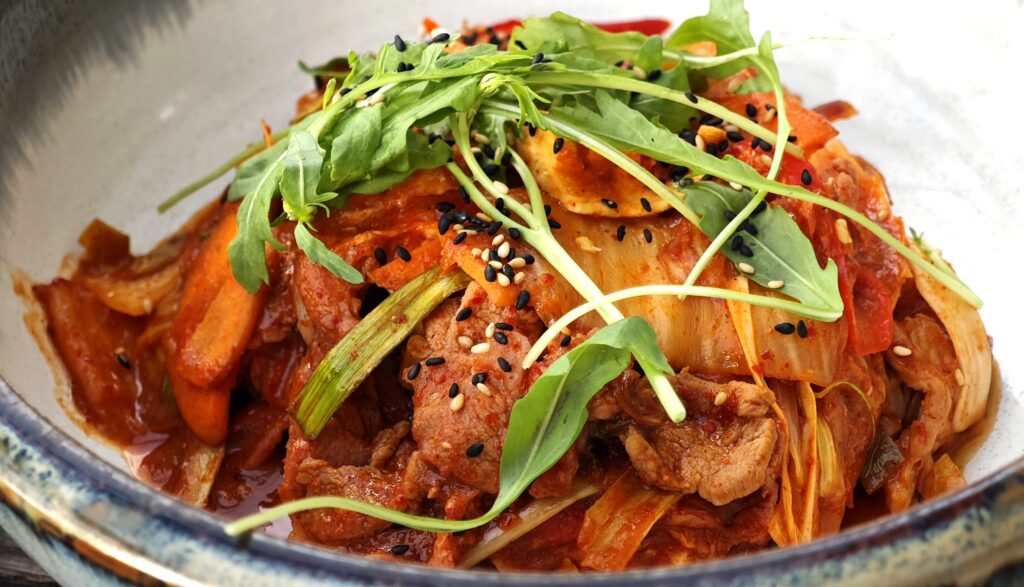Today, we’re introducing a restaurant that will surely resonate with many Korean food lovers. Located in the bustling Berger Street, this restaurant, Sonamu — meaning “pine tree” in Korean — instantly draws you in with its natural charm.
Just like its name, the restaurant’s design is deeply inspired by wood — from the rustic exterior to the cozy interior, you’ll find wooden elements everywhere, creating a simple, comfortable environment. Step outside and you’ll find a space partly surrounded by bamboo, adding a touch of serenity to this urban retreat. It’s a great place for both casual meals and business gatherings.
Restaurant Profile
- Name of the Restaurant: Sonamu
- Adress: Berger Str. 184, 60385 Frankfurt am Main
- Style: Korean Cuisine – street food, dumplings, noodles, rice bowls, stir-fries, stews
- Price: around 25 – 35 EUR per Person (incl. drinks and tips)
Bae Tschu Tschon makes for a nice appetizer, setting the stage beautifully for the rest of the meal. This crepe is made from fresh napa cabbage leaves, delicately cooked on a wheat-based batter. It’s fluffy and soft inside, with a lightly crisp, golden-brown exterior. Served with a savory soy sauce dip that adds a touch of umami, the flavors remain simple yet comforting, letting the fresh taste of the flour take the spotlight.

The presentation of this dish is very thoughtful. Imprinted on the pancake is a cabbage leaf shaped like a tree, a subtle nod to the restaurant’s name. It’s a small detail that ties the dish to the restaurant’s natural, calming vibe. With its light, comforting tastes, Bae Tschu Tschon sets a soothing foundation and prepares your palate for the flavors to come.

Galbi, or Korean braised short ribs, is a heartwarming dish traditionally enjoyed during special occasions in Korea, symbolizing warmth and family gatherings.


These beef ribs are marinated in a delicious blend of soy sauce, honey, and apples, creating a sweet, savory, umami taste. A hint of chili brings a slight kick. Slowly simmered, the ribs become incredibly tender, with just the right mix of lean and fat that makes each bite rich and indulgent.

It’s served with a variety of ingredients, including soft potatoes, carrots, fresh green onions, egg strips, peppery arugula, and broccoli, all contributing to balanced texture and flavor.

The broth is surely a highlight, with its deep, savory notes that are so heaty and flavorful you’ll want to savor every sip. Eat the rips with a fresh crunch of onions, and you’ll have an exciting contrast that elevates the rich, tender meat while providing a refreshing lift from the sharp, slightly pungent onions.
Bul Go Gi is certainly one of the most iconic dishes in Korean cuisine and a staple in many Korean households. This tasty stir-fry features tender meat marinated in a tantalizing mix of say sauce, ginger, garlic, leeks and mushrooms, and balanced with sweetness of apples, Korean pears, as well as honey.

At Sonamu, you can customize your Bul Go Gi with a choice of meats, including chicken leg (with bones removed), beef short ribs, and pork neck. While the beef version is the classic choice, we opted for the duck breast variant, Bul Go Gi Ori, which offers a uniquely deep, rich flavor. The mouthwatering marinades, especially Korean pears, with its naturally heightened sweetness, not only tenderize the meat, but also infuse it with a subtle fruity taste. They enrich the flavor and make the meat super moist and aromatic.
The veggie ingredients, including carrots, green onions, rucola, mushrooms, onions, broccoli, green beans, and glass noodles, pairs supremely with juicy, slightly chewy meat, highlighting its savory, slightly sweet taste.

The side soy sauce soup is rich, nutty, smoky, and fairly salty, so it’s best enjoyed in moderation. Bul Go Gi also comes with a bowl of rice, which, at Sonamu, looks a bit purple, indicating it’s made from a blend of grains. This adds a nutty flavor and additional nutrients to the meal.
Kim Sam Bok is a fiery Korean stir-fry. This dish features tender pork neck, a good mix of lean and fat, stir-fried with sour, crunchy kimchi (fermented, spicy, sour vegetable) and a generous helping of Korea’s famous gochujang—a spicy chili paste that adds depth, heat, and a hint of sweetness. This iconic condiment gives the dish its signature kick with an earthy, umami-rich flavor that’s really memorable.

The rich flavors of the pork are complemented by soft tofu, glass noodles, and sweet carrots, all topped off with black and white sesame seeds and fresh, peppery arugula for a fresh, nutty crunch. The interplay of tangy, fermented kimchi and the juicy, savory pork creates layers of flavor, making it spicy and packed with taste.
If you’re seeking a bold, spicy experience, Kim Sam Bok is a great choice – with heat, tang, and umami all in one dish.

Bibimbap is one of Korea’s most beloved dishes. It’s a balanced rice dish topped with a variety of vegetables and seasoned with sesame oil and spicy chili paste. At Sonamu, you can enjoy Bibimbap in two ways – either in a warm ceramic bowl with a fried egg and fresh arugula, or in a sizzling hot stone bowl (Dol Sot Bibimbap) with raw egg yolk, apple strips, and arugula. We chose the Dol Sot version, where the hot stone bowl crisps the rice and helps blend the ingredients as they are mixed at the table.

This dish can be made vegetarian or with various meats, such as beef, chicken, duck, or pork. We went for chicken that brings a tender, juicy layer to the mix.
It is accompanied by bamboo shoots, wood-ear mushrooms, shiitake mushrooms, eggplant, iceberg lettuce, zucchini, and a touch of chili. Plus, it comes with extra chili paste to kick up the heat!

Mix them well and let the flavors unfold —smoky, slightly sour, and mildly spicy, with a fresh, light touch from the veggies. The raw egg yolk melts into the rice, creating a rich creaminess, while the sizzling bowl gives the bottom rice a nutty, toasted crunch, balancing the fresh veggies and rich egg yolk.

If you’re looking for flavors, textures, and healthy ingredients, Bibimbap is the meal for you, offering comfort and excitement in every bite.

As well as the above, Sonamu also offers popular starters like Japchae (stir-fried glass noodles with vegetables), pan-fried Mandu (Korean dumplings), and Kimchi Jeon (savory kimchi pancakes). For mains, along with vegetarian and meat options like Dak Gang Jeong (Korean fried chicken), there are seafood specialties like Ojing-eo Bokkeum (spicy stir-fried squid). Small bowls of banchan are served at each table, including the essential kimchi, which balances flavors and aids digestion – a staple of Korean cuisine for good reason.
Though Sonamu’s menu is simple, it offers a glimpse into the heart of Korean cuisine. The use of stone bowls in Bibimbap, for example, traces back centuries, when early Koreans cooked legumes in stone pots, laying the foundation for today’s hearty stone-bowl dishes. By the 5th century, Buddhism fostered a rich tradition of vegetarian food, while the 7th century saw the rise of Korea’s signature spicy flavors with the introduction of spices like garlic and ginger. In the 10th century, with Mongolian influence, a variety of meats like pork, beef, and even seafood became staples alongside rice.
From spicy kimchi stir-fries to comforting, warm Bibimbap, each exquisitely crafted dish at Sonamu leads you, like a graceful opening ceremony, on a flavorful encounter through centuries of tradition and taste.





